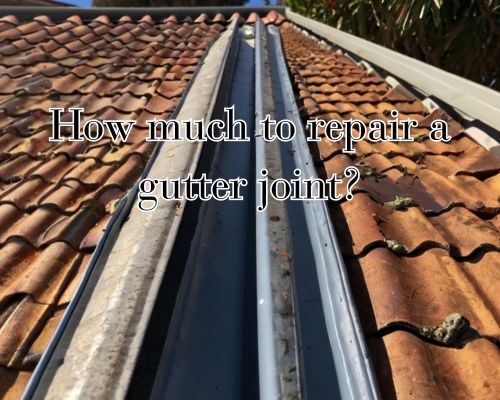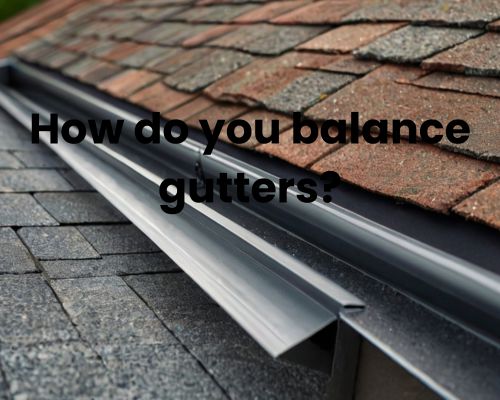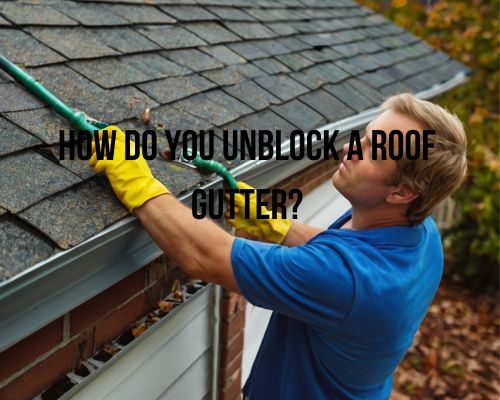If you have noticed water dripping from your gutter joint, it’s time to repair it before it causes more damage. A leaking gutter joint can lead to water damage on your walls, foundation, and basement.

Repairing a gutter joint is a crucial maintenance task. It should be performed as soon as possible to prevent further damage to your home. For an outside service, see gutter cleaning near me.
The cost to repair a gutter joint can vary depending on the extent of the damage and the type of gutter system you have. On average, repairing a leaking gutter joint can cost between $60 to $450.
However, if the damage is severe or if you have a complex gutter system, the cost can be higher. It’s important to get a professional quote before starting any repair work to avoid any surprises.
Understanding Gutter Joint Damage
Identifying Common Issues
Gutter joints are prone to damage due to continuous exposure to weather elements. If you notice water dripping from your gutters or pooling around the foundation of your home, it is likely that your gutter joints are damaged.
Some common issues that may arise with gutter joints include:
- Leaks: Water leaks from the joints, causing damage to the walls, foundation, and roof of your home.
- Separation: The gutter joints may separate from each other, causing water to flow out of the gutter system.
- Sagging: The weight of debris and water can cause the gutter joints to sag, leading to water pooling in the gutters.
Factors Influencing Repair Costs
Several factors can influence the cost of repairing a gutter joint. The extent of the damage, the type of gutter material, and the location of the gutter joint are some of the factors that can affect the repair cost.
Here are some factors that can influence the cost of repairing a gutter joint:
- Extent of damage: The extent of the damage to the gutter joint will determine the amount of repair work required and, consequently, the cost of repairs.
- Gutter material: The type of gutter material used in your home can influence the repair cost. For example, copper gutters may cost more to repair than aluminum gutters.
- Location of the gutter joint: The location of the gutter joint can also affect the repair cost. If the joint is located in an inaccessible area, such as the roofline, it may require additional equipment and labor to repair.
Repairing a Gutter Joint
If you have noticed that your gutter joint is leaking, it is important to repair it as soon as possible to prevent water damage to your home. In this section, we will discuss how to repair a leaking gutter joint.
We will cover DIY vs professional repair, cost estimation, selecting the right materials and tools, and a step-by-step repair guide.
DIY vs Professional Repair
Before repairing your gutter joint, you need to decide whether to do it yourself or hire a professional contractor.
If you have experience in DIY projects and feel confident in your abilities, you can save money by repairing the gutter joint yourself.
However, if you are not experienced in DIY projects or if the repair is complex, it is better to hire a professional contractor (see gutter cleaning near me) to ensure quality workmanship and safety.
Cost Estimation
The cost of repairing a gutter joint can vary depending on the location, material costs, and the extent of the damage. On average, the cost to repair a leaking gutter joint can range from $100 to $300.
However, if the damage is severe, a full gutter replacement may be necessary, which can cost between $500 and $2,000.
Selecting the Right Materials and Tools
To repair a leaking gutter joint, you will need the right materials and tools.
The materials you need will depend on the type of gutter you have, such as aluminum, copper, cast iron, or UPVC.
You will also need sealant, hangers, and metal flashing. The tools you will need include a ladder, drill, screwdriver, pliers, and a caulking gun.
Step-by-Step Repair Guide
Here is a step-by-step guide to repairing a leaking gutter joint:
- Safety first: Make sure the ladder is secure. Also, have a helper to hold it steady. Don’t forget to wear gloves and safety glasses.
- Clean the gutter: Remove any debris or leaves from the gutter. This will ensure that it is dry and clean.
- Locate the leak: Look for the source of the leak. Then, mark the area with chalk.
- Remove the old sealant: Use a screwdriver to remove the old sealant from the joint.
- Apply new sealant: Apply a generous amount of new sealant to the joint. You can use a caulking gun for this.
- Replace hangers: If the hangers are damaged, replace them with new ones.
- Install metal flashing: Install metal flashing over the joint to reinforce the seal.
- Test the repair: Run water through the gutter to test the repair. Make sure there is no overflow or leakage.








